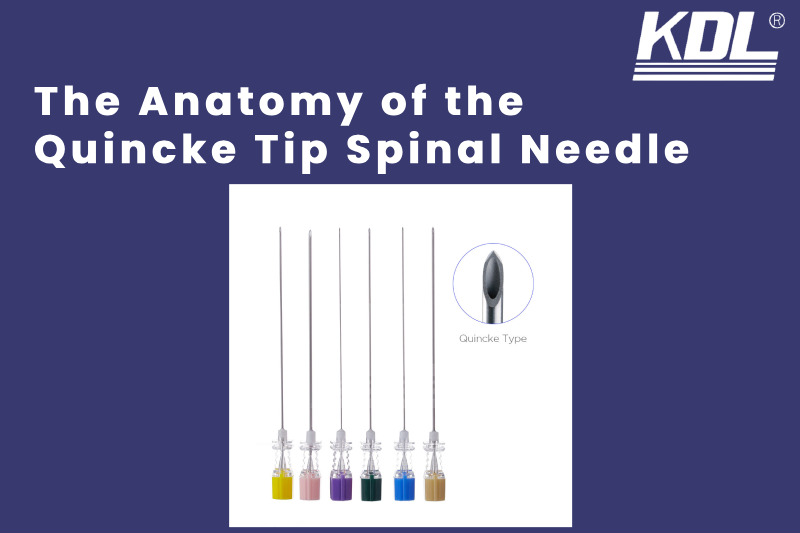
Spinal procedures are critical interventions that demand precision, expertise, and the right tools. Among these tools, the Quincke tip spinal needle holds a pivotal role. Understanding the anatomy of the Quincke tip spinal needle and its significance can enhance procedural outcomes and patient safety. In this comprehensive guide, we delve into the structure, benefits, and applications of the Quincke tip spinal needle, emphasizing its importance in spinal procedures.
What is the Quincke Tip Spinal Needle?
The Quincke tip spinal needle, named after German internist Heinrich Quincke, is a medical instrument design for lumbar punctures and spinal anesthesia. Its distinctive feature is the cutting bevel tip, which facilitates penetration through the dura mater. This needle is widely use due to its efficiency in providing access to the subarachnoid space.
Anatomy of the Quincke Tip Spinal Needle
The spinal needle is meticulously design to optimize its functionality. Here are the key components:
1. Bevel Tip
The most notable feature of the Quincke tip spinal needles is its bevel tip. The cutting edge of the bevel tip allows for smooth penetration through tissues. This design reduces the risk of deflection and ensures accurate needle placement.
2. Shaft
The shaft of the spinal needle is typically made of stainless steel, providing durability and resistance to bending. The shaft’s diameter and length vary based on the specific application and patient anatomy.
3. Hub
The hub of the needle is where the shaft is connected to the syringe or other medical apparatus. It is design for a secure fit, ensuring stability during the procedure.
4. Stylet
The surgeon inserts the removable component, the stylet, into the shaft of the needle. It prevents tissue from clogging the needle during insertion. Once the healthcare provider properly positions the needle, they remove the stylet to allow fluid withdrawal or drug administration.
Why the Quincke Tip Matters in Spinal Procedures
The needle is integral to the success of various spinal procedures. Here’s why it matters:
1. Precision in Needle Placement
The cutting bevel tip of the Quincke needle ensures precise placement, which is crucial for effective lumbar punctures and spinal anesthesia. Accurate needle placement reduces the risk of complications and enhances the effectiveness of the procedure.
2. Minimized Tissue Damage
The design of the Quincke tip minimizes tissue trauma. Its sharp bevel tip allows for a clean cut through the dura mater, reducing the likelihood of post-procedural headaches and other complications associated with tissue damage.
3. Versatility
The Quincke tip spinal needle is versatile and used in various spinal procedures, including diagnostic lumbar punctures, spinal anesthesia, and intrathecal drug delivery. Its adaptability makes it a preferred choice among healthcare professionals.
Read More About : Comparative Analysis of Spinal Needle Sizes
4. Enhanced Patient Safety
The precise design and functionality of the Quincke needle contribute to patient safety. By minimizing tissue damage and ensuring accurate needle placement, healthcare professionals significantly reduce the risk of adverse effects.
Applications of the Quincke Tip Spinal Needle
1. Lumbar Punctures
Lumbar punctures, also known as spinal taps, involve extracting cerebrospinal fluid (CSF) for diagnostic purposes. The sharp bevel tip ensures efficient and safe access to the subarachnoid space.
2. Spinal Anesthesia
Spinal anesthesia requires precise administration of anesthetic agents into the subarachnoid space. The needles design facilitates accurate delivery, ensuring effective anesthesia with minimal complications.
3. Intrathecal Drug Delivery
For patients who need long-term management of chronic pain or spasticity, healthcare providers often utilize intrathecal drug delivery. The Quincke needle ensures the precise placement of catheters for continuous drug infusion.
Choosing the Right Quincke Tip Spinal Needle
When selecting a Quincke tip spinal needle, several factors should be consider:
1. Needle Gauge
The gauge of the needle determines its diameter. Thinner needles (higher gauge) reduce patient discomfort and the risk of post-procedural headaches but may be more challenging to maneuver. Common gauges for spinal needles range from 22 to 27.
2. Needle Length
Choose the needle length based on the patient’s body habitus and the specific procedural requirements. Standard lengths range from 3.5 inches to 5 inches.
3. Material
Manufacturers make most spinal needles from stainless steel due to its durability and resistance to corrosion. However, some needles may have coatings to enhance smoothness and reduce friction.
Tips for Effective Use of Quincke Tip Spinal Needles
To maximize the effectiveness and safety of spinal needles, consider the following tips:
1. Proper Positioning
Ensure the patient is in the correct position to facilitate needle insertion. Common positions include the lateral decubitus position and the sitting position with flexed spine.
2. Aseptic Technique
Maintain strict aseptic technique to prevent infections. This includes proper hand hygiene, using sterile gloves, and disinfecting the puncture site.
3. Slow Insertion
Insert the needle slowly and steadily to reduce the risk of deflection and ensure accurate placement. Avoid sudden movements that could cause tissue damage.
4. Patient Communication
Communicate with the patient throughout the procedure to monitor their comfort and promptly address any concerns.
Conclusion
The Quincke tip spinal needle remains a cornerstone in spinal procedures due to its precise design and effectiveness. Understanding its anatomy and applications can enhance procedural success and patient outcomes. By selecting the appropriate needle gauge, length, and adhering to best practices, healthcare professionals can optimize the use of the Quincke tip spinal needle in various clinical scenarios.
 +86-791-8686-1216
+86-791-8686-1216 

